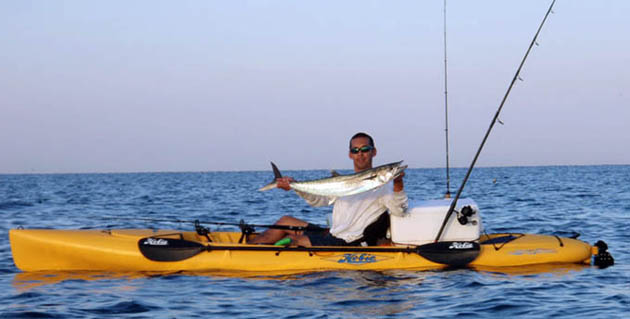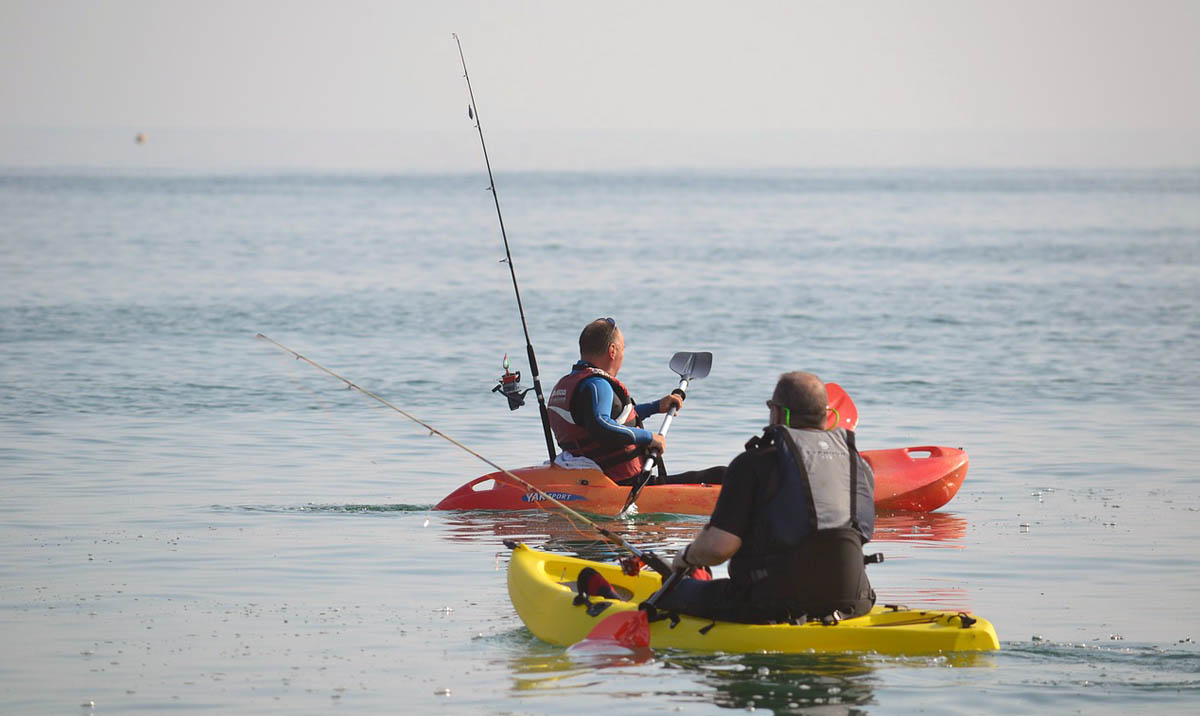By Mike Kogan
Summer is here and whether you are fishing in the Atlantic or the Gulf coast of Florida that means it’s time to target Scomberomorous cavalla, better known as King Mackerel or Kingfish. Kayaks are a great slow trolling platform for targeting Kings anywhere from right behind the breakers off the beach out to about 2 miles offshore. The biggest challenges for kayak anglers seeking Kingfish is the surf launch/recovery, managing the hookup, and finally dealing with landing and handling the fish after the fight.
Since you will be launching in the ocean all the usual ocean safety precautions need to be in effect. Make sure you have properly prepared for a surf launch and recovery, wear a PFD, always fish with at least one partner, have a waterproof floating handheld VHF at hand, and have fled a float plan. A GPS or rescue device like a Spot Personal Locator is also a good idea and rod tethers to make sure the rod stays on the kayak during a strike are essential.
Tackle and bait selection is similar to what you would use in a boat. Rods are 12-25lb 7′ medium action sticks for live bait trolling, and popular reels are Shimano’s Speedmaster and Baitrunner or Penn’s Torque series. Line is either 20-25lb monofilament or 40-50lb braid with a snap swivel for easy swapping of terminal rigs. For live and frozen baits use a standard Duster rig with either steel wire or the more pliant steel braid products with size 2, 4, or 6 treble hooks and a stinger dialed in for the size of your baits.
Your kayak needs to be equipped with a good baitwell if you want to fish live bait such as pogies – the built-in livewells featured on the Malibu Stealth kayaks or add-on baitwells such as the Shimano Bristol Bay Livewell Bag are ideal for keeping your bait alive and fresh. A fish finder can be a great aid when the bait is down and there a many affordable units available for kayaks from Lowrance, Eagle, and Humminbird.
The preferred live baits are pogies, blue runners, or goggle eyes which you can either net or jig up depending on whether the bait is behind the surf or down over some live bottom. In case you don’t find live bait it’s a good idea to take some frozen cigar minnows, ballyhoo, or ribbonfish – Williamson also has some nice artificials. Another nice product for fishing a ribbonfish down deep instead of slow trolling on the surface is the Scotty Portable Lake Troller. It’s a very simple no frills manual downrigger that can be setup on the yak or put on a gimbal in a flush mount rod holder.
The float plan on the east coast can vary depending on the winds and bait selection. If there are prevailing west winds in the morning you can get bait on the beach and let the wind take you out 1-3 miles offshore, fish the day, then let the late afternoon easterly sea breeze bring you back. Another good plan when there is a lot of bait on the beach is to troll the beach or go out a few hundred yards past a pier to slow troll. In the Panhandle you will more likely be fishing some structure which can be found closer to the beach.

(picture Courtesy of Chris Lewis)
Hooking up can be quite the fire drill if you have two (or more) lines out when trolling on a kayak. You are the only crew to manage or clear the line(s) when you get a hit, so keep it simple and don’t deploy more than two lines. I usually fish a single line down with a ribbonfish and another one up with a live pogie, and when I hear that drag scream I go into hyperdrive clearing the additional line.
The final challenge is actually landing the Kingfish. First thing is make sure the fish is tired – you’re about to have a close encounter with some serious teeth so make sure the fish is not green. If it’s not a very large fish and you intend on releasing it you can tail the fish, have your partner snap a quick picture, and do a release. Larger fish will require a lot more caution and if you intend to release a big one you are definitely taking a risk bringing a large live king onto your kayak.
If you intend to keep your catch a decent hand gaff will do the job, but remember now you need to get to shore and the blood in the water is going to attract some attention. Always remember to consider the risks and consequences before you take the next step. After catching a nice Kingfish your endorphins are telling your brain you’ve got to show your buds this awesome fish but just make sure you have a plan to safely get back!
For more information on kayak fishing in the northeast Florida area including detailed launches, routes, and fishing reports visit www.JaxKayakFishing.com, Jacksonville’s kayak fishing community.
Captain Mike Kogan (a.k.a. KayakMike) is a USCG licensed charter captain. He runs www.JaxKayakFishing.com, North Florida’s Kayak Fishing Community and hosts the Jacksonville Kayak Fishing Classic, the world’s largest kayak fishing tournament.

